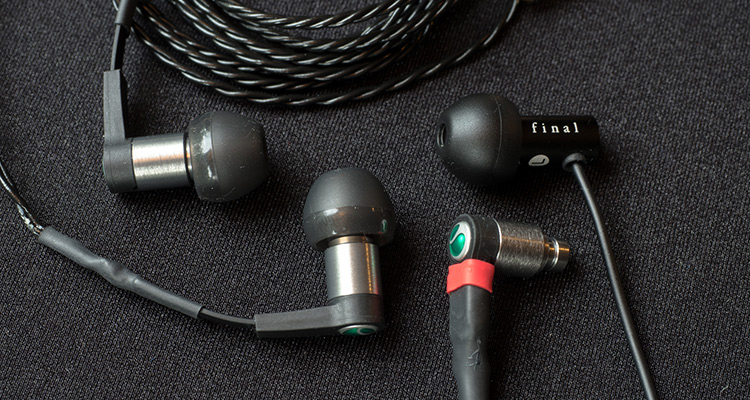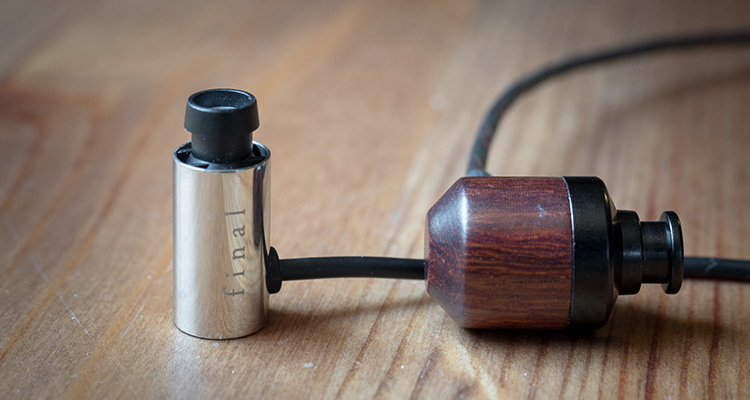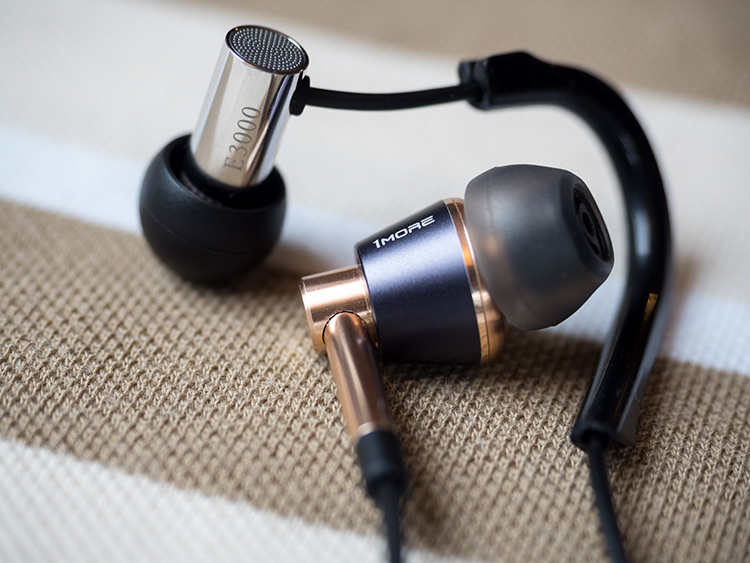Sound Impressions
During discussion of the sound, I will continue the double-review and discuss the E2000 and E3000 simultaneously. When reviewing the 1More Dual- & Triple-Driver, as well as the Etymotic ER4 SR & XR, I quickly chose a favorite each and focussed on a single unit.
This time it was not easy for me to pick a preference. Both E2000 and E3000 have their strengths that I consider worth a full and complete review. The E-series uses a small 6.4 mm dynamic driver and I expect both units to use the same driver with different dampeners. So let’s get straight to the main difference of the two.
Tonality
Starting with the E2000, I was positively impressed by the well-balanced tuning. The E2k have a mild loudness-correction with some boosted bass and some extra treble presence as a counterweight. The midrange sounds surprisingly accurate and realistic, which I think is the biggest strength of the smaller black brothers.
The shiny bigger brothers are tuned totally different. They’re warm with big bass and deep soundstage. But after giving the E3000 some time, they impressed me more and more with homogeneity. To see if the E3k are worth the extra cost over the E2k, we will have to take a more detailed listen.
Bass
E2000’s bass is around 5 dB above neutral, which isn’t an awful lot and just enough for a well-dosed added musicality. Sub-bass is present but not to a level that would satisfy a basshead. E3000, however, add another 3 dB and the bass sounds a lot darker and boomier. They appear to have a more controlled ground in the transition to the sub-bass and they’re capable of delivering some low-end rumble. Something that one would not expect from such a small IEM and definitely not from a semi-opened back design.
Bass Quality
The quality of bass is very similar on both. The bass is not particularly punchy or as quick as some balanced armature receivers are capable of. Neither does the bass deliver big slam as many other dynamic drivers do. The E series is somewhere in between with a quite relaxed and atmospheric bass that provides just enough detail in the texture to be enjoyable for strings and low-tuned bass guitars. It has a reasonably natural feel without standing out of the crowd. Even though the E3000 could have some quicker slam for Hip-Hop music, for my taste.
Mids
S’NEXT’s Final did very well with the midrange tuning. I, for one, am of the opinion that earphones should try to follow targets of near-field compensation. Especially v-shaped earphones often ignore the documented pinnae effects and instead try to balance the midrange’s fundamentals and harmonics via the bass and treble. This rarely works for my ears and thus I’m very pleased with Final Audio’s accuracy here. The designers definitely have some know-how and experience.
Timbre
The E2000 sound especially natural – or neutral in a positive way. Voices sound realistic and imitate the timbre one would expect from loudspeakers. Fullness is just right and electrical guitars have the crunch they need.
The E3000 follow that same target with a small but significant difference. The lower midrange is swayed by the stronger bass which adds weight to the mids and makes them come off as a bit muddy. I would wish for some more crunch and edge to balance the fullness. This tuning might be of preference for people who are scared of ’shouty’ mids or who like to listen to music at very low-pressure levels.
Treble
The E2000 has an absolutely formidable mid-range that shows no signs of coloration. However, it lies within the treble where Final decided to balance the moderate bass boost. At 7 kHz, particularly, the E2k have some extra decibels. Not enough to become sibilant, but well enough to create a more lively and forward experience. My ears made out a second minor peak at 10 kHz.
The E3000, on the other hand, hardly have pronounced treble. The highs aren’t technically recessed either, but they do lose presence under the heavy weight of the warm bass and midrange. The E3000 does without the treble quantity including the 7 kHz peak of the E2000 which can occasionally seem dull but after adjusting or listening to low volumes it can also be very homogenous.
Extension
Both members of the new E-series have a very good treble extension that seems limited by my personal hearing only. But I also don’t claim to hear up to 20 kHz, mind you.
I do have to note that the treble of the more expensive E3000 has audible channel imbalance. When listening to music, channel imbalance in the treble is hard to tell, because usually cymbals are not centered on the recording.
Using an audio software that lets you switch left and right channels on the fly will make it more apparent. Anyway, I hope this small flaw is limited to my review unit only, but nonetheless, it is an issue that weighs into the final score. The cheaper E2000 has perfectly matched drivers for left and right.
Soundstage and Resolution
Pick your poison. This review category shows why Final released both IEMs. Their tunings serve different purposes and their qualities drift apart right at this stage. I will switch things up and start with the E3000 for once.
The shiny E3k have an incredible headroom. The bass and it’s authoritative low-end push the listener back several rows within the virtual soundstage. I feel like all instruments have a respectable distance and allow full monitoring across the frequency range. The homogeneity
continues and once the brain adjusts to the warm tuning, there isn’t a single instrument that sticks out – except for maybe the deepest rhythm section.
The E2k cannot compete with the expansive and especially deep soundstage. Using the E2000, the listener is a lot closer to the music and the soundstage does not feel very big. However, they do just as well with layering.
The boosted lower treble also helps with perceived resolution and it is much easier to pick up details like the breathing of the vocalist. Once both IEMs are equalized, the differences in soundstage and resolution become void. On a side note that might be interesting to some, I found that it is easier to just lower bass quantity and equalize the E3000 than it is to flatten the E2000.
Matchability
One thing to note here is that the E2000 is louder than the E3000. I roughly elevated the E3000 by 3 dB to match voices. Final rated them at 100 dB/mW and 102 dB/mW. Both are very tolerant with sources.
The E2000 will pick up hiss a bit easier but nowhere are they ultra-sensitive. I would have to lie to myself if I would claim to hear sonic improvements when pairing them with different sources such as an AK70 or iBasso DX200. When compared to the default iPhone 6S output, the iFi iEMatch did not bring any advantages that I could notice.
Select Comparisons
Sony MH1
The Sony MH1 has been a long-time favorite of mine. I bought three pairs over the years and I still have two recabled pairs on me right now. The stock MH1C package is an abomination and doesn’t stand a chance against the soft cable and attractive accessories of the E series. But the small bullet design is easy to handle and I am very happy about Final’s similar design.
The E2000 are not only more attractive, but they actually manage to offer a more neutral presentation than the MH1. Compared to the Sony, the FADs seem slightly bright and somewhat lacking in the sub-bass.
Midrange Accuracy
However, the midrange is more accurate and the treble is more resolving for better detail resolution. The treble is also less colored and I can see plenty of users preferring the E2000 over the MH1 when they don’t need the high isolation the Sony offers. Since the MH1(C) are anything but consumer-friendly, I gladly add the E2000 to the list of sub 50 $ recommendations.
Bass Edge
As a bassy contender, the MH1 beat the E3000 with punch and slam. Rumble in the lower octaves feels tighter and overall decay seems to outpace the E3000. The transition to midrange of the MH1 is also better purged, bleeding less into the vocal range.
Vocal Presence
What makes an even bigger difference, IMO, is that the Sony have some extra boosted vocal presence at around 3-4 kHz. This gives the midrange the much-needed counterweight to the warmness with crunch and edge that I missed in the review earlier. However, the E3k are more consistent and transparent in the higher frequencies. This is not enough to secure a win, though, and sonically I ultimately have to give the advantage to Sony’s legendary ultra-budget MH1.
Unfortunately, the MH1 are also not known for audiophile driver matching either and their default cable is an unacceptable mess. If you are not a fan of custom cable mods, the E3000 might serve the overall more attractive package.
Shozy Zero
Wood
The Zero is similarly priced as the E2000 but boasts a premium rosewood body. Shozy opted for a larger driver but still managed to keep the build small. The E-series is longer and thinner which could lead to improved comfort for small ears.
Whether you prefer wood or metal is entirely subjective. I think both IEMs are very pretty for the price but Final definitely has the better cable and accessories. Important to note is that the Shozy Zero have much better isolation. But it also allows the driver to click when inserted due to air pressure which is always a little bit uncomfortable for me.
Warmth
The Zero has a very smooth and warm signature. It makes little sense to compare them with the more neutral E2000. The E3000 thus proves to be the more suitable contender.
Bass
Bass quantity of both is very similar. My brain always needs some time to adjust to warm signatures. The Zero is easier for me to get into due to a moderate 6 kHz peak. Even though the midrange is recessed, the lower treble quantity is just enough to give it a lively presentation. Even though the E3000 has a more accurate midrange, they appear softer and more mellow as they lack any sort of balancing treble boost.
Coherency
Once my mind has adjusted, though, the tuning of the E3000 proves to be more homogenous. Occasionally the Zero can cross the border to sibilance, at which times I prefer the E3000. However, the Zero has some advantages like faster attack and better punch, but they cannot compete with treble tone, extension, and soundstage size. Perhaps the E3000 is a little bit more refined, but I also sympathize with the bravery of the Zero that brings a lot of fun to the music. The battle between Final E3000 and Shozy Zero is one with many casualties but no clear winner.
1More Triple-Driver E1001
After the review early this year, I continued to often use the Triple-Driver as a headset. The Dual-Driver EO323, however, only seldom left their box. Both have a similar tuning that can best be described as a W-shape. Their build quality is still exceptional for the price and even though the two Finals have a more serviceable design, they don’t quite match the premium feel of 1More.
THX
THX just recently certified the E1001 (and the Quad-Driver) so it was interesting to grab the E1001 again and have a closer listen. I adjusted quickly and managed to enjoy the sound at lower volumes.
Treble
Switching to the Final E2000, I suddenly noticed how much treble information I was missing. 1More’s hybrids sound a lot softer in the treble, though not losing any energy overall. The Triple-Driver focus more on the rhythm section and balance the bass in the vocal presence area. The treble picks up at the top end after a strong dip and then extends far into the high frequencies. It is a tuning that I never thought would work when seen on paper. But somehow it does.
Coherency
Even though the E2000 lack the wow-factor, they impress with coherency and prove to be a lot better suitable for picking up small details in the music. The timbre of trumpets in Jazz recordings is the most noticeable advantage, in my opinion. The Final also have better driver matching in my case.
Bass
Even though the 1More measure much stronger bass, they don’t seem to quite match the exaggerated fullness of E3000’s low-end. The balanced signature works as a double-sided sword, though. While I have to attest better tonality, I also have to say that the presentation of the Triple-Driver feels a bit cramped in comparison and can only compete with Final’s soundstage depth. The E3000 expand further in width and have a more spacious feel. The E3000 works better for the Classical genre whereas the 1More have a stronger Pop/Rock vibe going on.
The two Final dynamics have no problem keeping up with the resolution of 1More’s hybrid design, but aside from tuning do not surpass it either.
Our Verdict
The two new Final E-type IEMs are a pleasant surprise. Both the E2000 and E3000 offer a very attractive package with terrific ear tips and useful ear guides. Apart from lacking a hard case, there is barely any open attack surface. Comfort and build quality are as simple as they are useful.
The difference of E2000 and E3000 mostly lies within the tuning. The tonality of the smaller brothers is very well balanced and they do a terrific job as a backup or portable pair for serious detail aficionados. The warmer E3000 is perhaps even more refined but they will take some time to grow on the listener. Of my hifi friends, I am perhaps the one who least likes a warm signature but I kept grabbing the E3000 more often than I thought. They serve extremely well as a nightly companion on the bed stand.
Final’s 6.5mm driver is pretty quick but not enough to punch outside the sub-100 $ price category. The vented design helps a lot in this regard but it also means that the isolation is below average for an IEM. The E3000 use this as an advantage for a big soundstage. Ultimately I do think that the E2000 is even more attractive for the price.
Technical Specifications
E2000 | E3000
- Accessories: 5 pairs E-type ear tips, ear guides, pouch
- Weight: 12g | 14g
- Driver: 6.4mm dynamic driver
- Impedance: 16 Ω
- Sensitivity: 102 dB/mW | 100 dB/mW
- Cable length: 120cm








